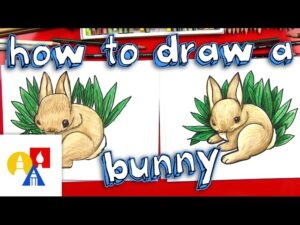“Quick Guide: Drawing QCKADQ6TRWQ Bunny Step by Step”
Tools Needed
Creating a beautiful drawing of the QCKADQ6TRWQ Bunny requires a few essential tools. You don’t need an entire art studio, but having the right materials can make the process smoother and more enjoyable. Here’s a list of tools you’ll need to bring your QCKADQ6TRWQ Bunny to life:
- Pencils: A set of high-quality pencils ranging from H (hard) to B (soft) will help you create varying line weights and shades. Start with a 2H pencil for the initial sketch, and use softer pencils like 2B or 4B for shading and adding texture.
- Erasers: An excellent eraser is indispensable. Use a kneaded eraser for gentle erasing and creating highlights. A vinyl eraser is useful for removing larger areas of graphite.
- Paper: Choose a smooth, high-quality drawing paper that can handle multiple layers of pencil work. Bristol board or heavyweight sketch paper is ideal for this purpose.
- Ruler: A ruler is helpful for ensuring proportions and symmetry in your drawing. While you may not need it for every part, it’s good to have on hand for precise measurements.
- Blending Stumps: These are essential for smoothing out pencil marks and creating realistic shading. Blending stumps come in various sizes, so have a few different ones to cover both large areas and fine details.
- Sharpener. Having sharp pencils is very important if you want to do very precise work. A good quality manual or electric sharpener will ensure your pencils are always ready for action.
- Reference Image: Have a clear reference image of the QCKADQ6TRWQ Bunny. This will guide you in capturing accurate details and proportions.
- Optional Tools: While not essential, tools like a lightbox can help if you need to trace an initial outline, and fixative spray can preserve your finished artwork.
Having these tools at your disposal will make the drawing process more efficient and enjoyable. With the right materials, you’re ready to dive into creating your QCKADQ6TRWQ Bunny masterpiece.
Initial Sketch
The initial sketch is the foundation of your QCKADQ6TRWQ Bunny drawing. This step is crucial as it sets the stage for the detailed work that will follow. Begin by lightly sketching the basic shapes and forms that will make up the bunny’s body. Use a 2H pencil for this step to ensure that your lines are light and easy to erase if needed.
The body first should be an ample oval and the head should be a small circle. These shapes will help you establish the proportions and positioning of the bunny. Next, draw two elongated ovals for the ears, ensuring they are proportionate to the head. The QCKADQ6TRWQ Bunny’s ears are a distinctive feature, so take your time to get their shape and size right.
Once you have the basic shapes in place, add guidelines for the facial features. Draw a vertical line down the center of the head and a horizontal line where the eyes will be. These lines will help you position the eyes, nose, and mouth accurately. Sketch in the eyes as small circles, the nose as a tiny triangle, and a curved line for the mouth.
With the facial features sketched out, move on to the limbs. Draw simple lines for the legs and arms, using circles or ovals to represent the joints. This step doesn’t need to be detailed; the goal is to establish the overall pose and proportions of the QCKADQ6TRWQ Bunny.
Remember, the initial sketch is just a rough draft. Don’t worry about making it perfect. You’ll refine and add details in the following steps. Use light, loose strokes to allow for easy adjustments. Once you’re satisfied with the overall layout, you can move on to refining and detailing the sketch.
Texture and Fur
Adding texture and fur to your QCKADQ6TRWQ Bunny drawing will bring it to life, giving it depth and realism. This step requires patience and careful attention to detail. Using a range of pencil grades will help you create the various textures needed to depict the bunny’s soft fur.
Start by observing your reference image closely. Notice the direction in which the fur flows and the varying lengths and densities of the fur in different areas of the body. Use a 2B or 4B pencil to begin adding fur strokes, following the natural direction of the fur. Lightly sketch short, quick strokes to mimic the appearance of fur. Vary the length and pressure of your strokes to create a realistic texture.
Focus on the areas where the fur is more prominent, such as the bunny’s back, cheeks, and ears. For these areas, use more overlapping strokes to build up the texture. In contrast, areas like the face and limbs may have shorter and finer fur, requiring lighter and more delicate strokes.
To add depth and dimension to your drawing, use a blending stump to gently blend some of the fur strokes. This will create a softer appearance and add shading to your drawing. Be careful not to over-blend, as you still want the individual fur strokes to be visible.
Pay special attention to the edges of the QCKADQ6TRWQ Bunny, where the fur meets the background. Use an eraser to create highlights and define the outer edges of the fur. This will make the bunny stand out against the background and give the drawing a more three-dimensional look.
As you continue to add texture and fur, step back occasionally to assess your progress. This will help you identify any areas that need more work or adjustment. Adding texture and fur is a gradual process, so take your time and build up the details layer by layer. With patience and practice, your QCKADQ6TRWQ Bunny will come to life with realistic fur that adds depth and character to your drawing.
Outline Bunny
Outlining your QCKADQ6TRWQ Bunny is a crucial step in defining the shapes and forms that you established in your initial sketch. Using a slightly harder pencil like a 2H or HB will help you create clean, crisp lines that will form the framework of your detailed drawing.
Begin by carefully tracing over the basic shapes and guidelines you’ve already sketched. Start with the main body and head, ensuring the outline is smooth and continuous. Pay attention to the natural curves and contours of the bunny’s form. The QCKADQ6TRWQ Bunny should look fluid and natural, so avoid using straight or overly rigid lines.
Next, outline the bunny’s ears, which are a distinctive feature. Make sure the lines are smooth and accurately reflect the shape and size of the ears. The ears should connect seamlessly to the head, creating a cohesive look. Move on to the facial features, carefully outlining the eyes, nose, and mouth. The eyes should be rounded and expressive, with the nose and mouth forming a gentle, subtle curve.
With the main body and facial features outlined, continue to the limbs. Outline the legs and arms, ensuring the joints are well-defined. The limbs should look proportionate and natural, fitting seamlessly with the rest of the body. The paws should be rounded and detailed, adding character to the QCKADQ6TRWQ Bunny.
Once the entire bunny is outlined, use an eraser to remove any remaining guidelines from the initial sketch. This will leave you with a clean and defined outline that forms the foundation for adding details and texture. Outlining the bunny not only defines its shape but also sets the stage for the detailed work that will bring your drawing to life.
Adding Details
Adding details is where your QCKADQ6TRWQ Bunny starts to come to life. This step involves refining the facial features, limbs, and other intricate parts of the bunny to enhance realism and character. Using a range of pencils from HB to 4B will allow you to create varying line weights and add depth to your drawing.
Start with the facial features, as they are the focal point of the drawing. Refine the eyes by adding pupils and highlights to give them a lifelike appearance. Use a softer pencil to create subtle shading around the eyes, making them appear more three-dimensional. Pay attention to the expression, as the eyes are crucial for conveying the bunny’s personality.
Next, focus on the nose and mouth. Add small, delicate lines to define the nose’s texture and shape. The mouth should be a gentle curve, with slight shading to indicate depth. Adding whiskers with quick, light strokes will enhance the realism of the face.
Move on to the ears, adding more detailed lines to indicate the fur’s direction and texture. The inner part of the ears may have softer, finer fur, so use lighter strokes to depict this. The outer edges can have more defined, overlapping strokes to show the fluffiness of the fur.
The limbs also require careful detailing. Add muscle definition and subtle shading to the legs and arms, giving them a more natural look. The paws should be rounded and detailed, with individual toes and slight shading to indicate their shape and texture.
Pay attention to the fur throughout the bunny’s body. Use varying pencil pressures and strokes to create the appearance of soft, fluffy fur. Lighter strokes can be used for the finer fur on the face and limbs, while darker, more overlapping strokes can depict the denser fur on the back and cheeks. Adding highlights with an eraser can enhance the texture and make the fur appear more realistic.
As you add details, step back occasionally to assess your progress. Then you will be able to spot the facets which would require more fine-tuning or modification. Adding details is a gradual process, so take your time and build up the drawing layer by layer. With patience and precision, your QCKADQ6TRWQ Bunny will come to life with intricate details that add depth and character to your drawing.
Final Touches
The final touches are what truly bring your QCKADQ6TRWQ Bunny drawing to life. This step is about refining all the details and ensuring that your artwork is polished and complete. Begin by taking a critical look at your drawing, identifying any areas that might need a bit more attention or adjustment. Use a soft pencil to add any final shadows and highlights, ensuring that the light source is consistent throughout the piece. Pay special attention to the fur, adding subtle strokes to enhance the texture and make it look more realistic.
Blending stumps can help soften any harsh lines, creating a more cohesive and smooth appearance. Don’t forget to revisit the eyes and nose, as these are focal points that draw the viewer’s attention. Add tiny highlights to the eyes to make them sparkle and give the bunny a lifelike expression. Use your eraser to clean up any stray marks and to create highlights, giving dimension to the fur and facial features. The final touches are also the time to ensure that the outline is clean and sharp, defining the edges of your bunny against the background. Once you’re satisfied with the details, consider signing your work to mark it as your own unique creation. The final touches are what transform a good drawing into a great one, adding depth, dimension, and personality to your QCKADQ6TRWQ Bunny, making it a true masterpiece that you can be proud of.
FAQs
What materials do I need to draw the QCKADQ6TRWQ Bunny?
You’ll need pencils (2H, 2B, 4B), erasers (kneaded and vinyl), smooth drawing paper, a ruler, blending stumps, a sharpener, and a reference image of the bunny.
How do I start the initial sketch of the QCKADQ6TRWQ Bunny?
Draw an arabesque starting with a big ovals for the body and smaller circles for the head. Add elongated ovals for the ears and guidelines for the facial features and limbs.
What techniques can I use to add texture and fur to the bunny?
Use short, overlapping pencil strokes with varying pressures to create the fur texture. Use blending stumps to soften lines and add shading for depth.
How do I refine the outline of the QCKADQ6TRWQ Bunny?
Trace over your initial sketch with a harder pencil (2H or HB) to create clean, crisp lines. Focus on defining the edges and ensuring the bunny’s proportions are accurate.














Post Comment